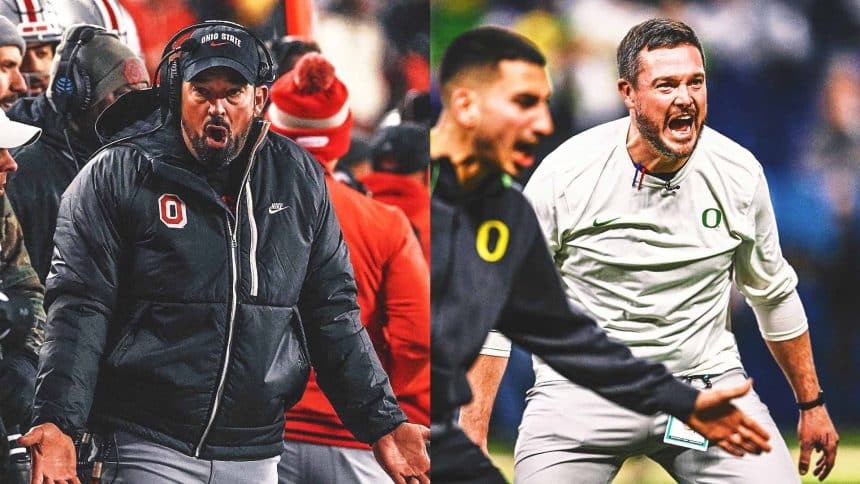A little more than five months ago, during the third week of July, the opening soliloquy for Oregon head coach Dan Lanning at Big Ten Football Media Days in Indianapolis lasted nearly nine minutes.
It began with a customary expression of gratitude for conference commissioner Tony Petitti, who welcomed the Ducks into their new league earlier this year, and included an overview of the Lanning family’s summer: a family vacation in Missouri, a stint at church camp for his three sons, a wife “ready to send me back to work” after a bit too much time together. He detailed the tragic loss of former cornerback Khyree Jackson in a multi-car accident that shook the program, a coaches’ retreat for his staff in Central Oregon and some of his team’s off-field efforts to strengthen the culture, from reading “The Art of War” by Sun Tzu to working with Sleep in Heavenly Peace and providing more than 200 beds for children in need.
For some of the reporters in attendance at Lucas Oil Stadium that morning, and for the television audience watching live on Big Ten Network, this was a formal introduction to a coach who would quickly become one of the conference’s leading figures. Oregon was set to enter the 2024 season ranked No. 3 in both the AP Poll and the AFCA Coaches Poll — the highest of all Big Ten teams not named Ohio State — and that meant Lanning shouldered much loftier expectations than his counterparts at USC, UCLA and Washington, the other three exiles from a crumbled Pac-12. And Lanning concluded his opening remarks by leaning into everything Oregon already claims to be and the new heights it’s hoping to reach.
“What should the Big Ten know about Oregon?” Lanning asked rhetorically. “We’re mighty different, mighty different in a lot of ways. … We’re mighty different when it comes to the jerseys we get to wear or the facilities we’re in. We’re innovative. We’ve always been on the cutting edge of everything we do. We certainly positioned ourselves to be on the cutting edge, and we’re grateful for the opportunity to compete in the Big Ten.”
ADVERTISEMENT
Right away, Oregon was positioning itself as a willing challenger to the conference’s old guard, to the schools like Ohio State and Michigan and Penn State that have ruled the Big Ten for so long. The blue bloodedness that was bestowed upon those programs in a previous century — and which persists to varying degrees in the present — is a much fresher experience for the Ducks, who had never won 10 games in a season until former coach Mike Bellotti did it in 2000 but have now done so 12 times over the last 17 years, including three in a row under Lanning. And even though Oregon is still searching for the first national title in school history, its Rose Bowl rematch next week against Ohio State, a team it already beat in mid-October, feels very much like a battle for modern Big Ten supremacy between the two teams with larger financial war chests than anyone else in the league.
A fascination by the rest of the conference with Oregon’s financial prowess, much of which is backed by Nike co-founder Phil Knight, who has reportedly donated more than $1 billion to his alma mater and is a driving force behind the Ducks’ aggressive NIL efforts, became increasingly clear at media days. Lanning and the select players who joined him in Indianapolis faced question after question from beat writers chronicling other teams about the monetary benefits of playing at Oregon. There was even a quip from first-year UCLA head coach DeShaun Foster about how the Bruins will abide by the revenue-sharing limits expected to accompany the impending House vs. NCAA settlement, while the Ducks have what seems to be a bottomless well of cash at their disposal. The sheer breadth of monetary discussion made it clear that Oregon was the Big Ten’s shiny new toy, even if the inquiries were tinged with envy.
“With the NIL side of things,” said quarterback Dillon Gabriel, who transferred in from Oklahoma following the 2023 campaign, “I think people are a little more — I wouldn’t say jealous, but it’s not like resources where everyone has got a training room, a weight room, a locker room, things they can show off, uniforms. It’s a little different with NIL, and you’ve either got it or you don’t. It’s just the new day and age of college football. You’re either catching up or you’re taking advantage of it, and hopefully you’re not on the wrong end of it.”
The combination of strong financial backing from Oregon’s Division Street collective and an unrelenting approach to roster building from Lanning has positioned the Ducks as arguably the only team in the Big Ten capable of competing with Ohio State in player acquisition. Lanning’s three recruiting classes have improved from 13th nationally in 2022 to ninth nationally in 2023 to third nationally in 2024, two spots ahead of the Buckeyes. It marked the first time someone other than Ohio State finished atop the conference’s recruiting hierarchy since Michigan did so under former coach Jim Harbaugh in 2019 and just the second time it’s happened since 247Sports began the team rankings in 2010.
Oregon’s current recruiting class, which won’t be completed until February, sits fifth in the national rankings — one spot behind the Buckeyes — but claims the highest average prospect score (93.85) of any team in the country with nine signees among the top 131 overall players. That includes five-star cornerback Na’eem Offord (No. 10 overall, No. 3 CB) from Birmingham, Alabama, whom the Ducks flipped from Ohio State. Offord became the second blue-chip prospect in as many classes to flip from Ohio State to Oregon, following in the path of four-star wideout Jeremiah McClellan (No. 65 overall, No. 14 WR) in the 2024 cycle. No players pledged to the Ducks have decommitted and chosen the Buckeyes since Lanning arrived three years ago.
“When we’re evaluating talent that can come here and help us,” Lanning said in a news conference earlier this week, “[we want to know] are you looking for the best opportunity, or are you looking for the easiest opportunity or most convenient opportunity? In our program, we talk about sacrifice. Sometimes you sacrifice distance for the right place, the right fit, the right place you’re going to develop. And we’ve had a lot of success doing that.”
Though Ohio State still narrowly edges Oregon in high school recruiting, which head coach Ryan Day refers to as the “foundation” of his program, the inverse has been true in the transfer portal, a newer tool in roster building and one that Lanning and the Ducks use quite liberally. After cobbling together the nation’s 23rd-best transfer haul in Lanning’s first offseason, Oregon shot up the portal rankings to ninth in 2023 and second in 2024, with the most recent group headlined by impact players at quarterback (Gabriel), cornerback (Jabbar Muhammad from Washington), defensive line (Derrick Harmon from Michigan State and Jamaree Caldwell from Houston), wide receiver (Evan Stewart from Texas A&M) and kicker (Atticus Sappington from Oregon State), among others. The portal is often where money talks the most.
For Ohio State, however, it wasn’t until this past offseason that Day put together a transfer class ranked among the top 25 nationally, as the program was slower to embrace the portal’s never-ending bidding wars and general absence of regulation. But the Buckeyes made the sport’s biggest splash in 2024 by signing a handful of elite players, headlined by former Alabama safety Caleb Downs (No. 1 transfer, No. 1 S), former Alabama quarterback Julian Sayin (No. 6 transfer, No. 1 QB), former Ole Miss tailback Quinshon Judkins (No. 9 transfer, No. 1 RB), former Kansas State quarterback Will Howard (No. 41 transfer, No. 7 QB) and former Alabama center Seth McLaughlin (No. 110 transfer, No. 4 IOL). All told, Ohio State’s incoming transfers ranked as the ninth-best group nationally with the highest average prospect score (92.86) of any program.
“There’s been a lot of talk about our team this year, a lot of talk about the NIL conversation,” Day said in a news conference earlier this week. “But the majority of this team are guys that decided to come back, not guys that decided to come to Ohio State [from the transfer portal]. Certainly we did add some big pieces in the portal, and that was very important for our team and those guys have been great members of our team and have quickly understood what it means to be Buckeyes. But in order to have that stability, I think that you’ve got to recruit high school players, tell them exactly what it’s going to be [like in college], and then follow up and treat them exactly the way that you recruited them in the process.”
The overwhelming success of both programs in the roster-building phase of college football helped explain the fever-pitch excitement that surrounded their regular-season showdown at Autzen Stadium on Oct. 12, a game ultimately won by the Ducks, 32-31. At the time, many believed they were watching a preview of this year’s Big Ten Championship Game, with Oregon and Ohio State both tipped as favorites to return to Lucas Oil Stadium in early December. The former held up its end of the bargain by steamrolling through conference play unbeaten. The latter was upended by Michigan in the regular season finale, which sent Penn State to Indianapolis instead.
Now their rematch will be held in a setting far grander — a College Football Playoff quarterfinal — with modern Big Ten supremacy and the path toward a national championship at stake.
“We’re extremely excited about obviously getting to play a great opponent in Ohio State,” Lanning said. “I think that’s a great representation of what the Big Ten is capable of, having these two teams with the opportunity to face off in ‘The Granddaddy of Them All.’”
Michael Cohen covers college football and basketball for FOX Sports with an emphasis on the Big Ten. Follow him at @Michael_Cohen13.
[Want great stories delivered right to your inbox? Create or log in to your FOX Sports account, follow leagues, teams and players to receive a personalized newsletter daily.]
recommended

Get more from College Football Follow your favorites to get information about games, news and more











